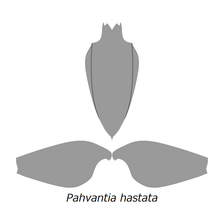帕凡特虾属
| 覆矛帕凡特虾 | |
|---|---|

| |
| 科学分类 | |
| 界: | 动物界 Animalia |
| 门: | 节肢动物门 Arthropoda |
| 纲: | †恐虾纲 Dinocaridida |
| 目: | †放射齿目 Radiodonta |
| 科: | †赫德虾科 Hurdiidae |
| 属: | †帕凡特虾属 Pahvantia Robison & Richards, 1981 |
| 种: | †覆矛帕凡特虾 P. hastata
|
| 二名法 | |
| †Pahvantia hastata Robison & Richards, 1981
| |
覆矛帕凡特虾(学名:Pahvantia hastata)是帕凡特虾属(学名:Pahvantia)的唯一个物种,生活在中寒武世,现在已灭绝。帕凡特虾的头部骨片很细长,两侧对称,形状类似矛。头部骨片突出的圆形的部分是整个骨片后面最宽的地方,大约位在头部骨片的约为三分之一。头部骨片侧边往下收缩,两个柄状突起几乎平行,后面的部分边缘比较尖锐[2],全身大约低于25厘米。[3]与其他的赫德虾一样,都有3个骨片。[4]滤食性动物的小型奇虾与筛虾属(Tamisiocaris)[5]和海神盔虾属(Aegirocassis)一样[3][6],可能可以微型浮游生物(包括大型浮游植物)或是以悬浮在水中的食物颗粒为食。[3][7]鲁迪·勒罗西-奥布里尔(古生物学家,Rudy Lerosey-Aubril)和史蒂芬·帕茨(古生物学家,Stephen Pates)发现到帕凡特虾的附肢,可以加确定帕凡特虾是奇虾的一种。[3]
命名与发现
[编辑]Pahvantia是由美国犹他州的西部美洲原住民(印地安人)称作帕凡特(Pahvant)转变而来,种小名hastata则是源自拉丁文的hastatus,意思是茅、剑的意思。[2]帕凡特虾来自美国犹他州的房屋山脉(House Range)和车夫页岩(Wheeler Formation)。[2][3][1]Robison和Richards发现KUMIP 134878、KUMIP 134187和KUMIP 134879,[2]鲁迪·勒罗西-奥布里尔发现和史蒂芬·帕茨KUMIP 134187、KUMIP 314089、KUMIP 314090[3](帕凡特虾的附肢和头部骨片化石,KUMIP是Museum of Invertebrate Paleontology University of Kansas的简写)。[2]
型态
[编辑]骨片
[编辑]头部骨片(H骨片)的尖矛形或是披针形的轮廓,前面有一根微小的矢状刺,后面的边缘是锯齿状。[2]侧面骨片(P骨片)整体很细长,后面的边缘有稍微凹陷和前面的突出物呈钩形(这个钩形是P骨片用来连接的部分,称作P骨片颈[8][9])。[2][3]帕凡特虾的头部骨片(H骨片)与其他物种,例如:海神盔虾属,类似三角形的形状。虽然帕凡特虾如其他的赫德虾一样在骨片后有眼凹口(ocular notch,眼睛所在之处)但是大小比起显爪虾和巨盔虾的眼凹口还小了许多。[9]

有保存问题的附肢
[编辑]

梗末节(peduncle,指附肢的梗节最靠近头部的节)特别狭窄,末端变宽,可能是地层的倾斜方向和/或不完整的保存。一开始Rudy和Pates发现的附肢化石中,由于保存问题,只能猜测大约有5个分节(podomere)。
Rudy和Pates发现大量的长毛状结构,当时将其称为刚毛(setae)。在更靠近头部有类似前附肢棘(endite,指附肢上的棘)的形状,与其他的前附肢棘有很大差异。靠近头部的两个前附肢棘是短而坚固的板状结构,每个都有七个排列成两排的前附肢辅刺(auxiliary spines,指前附肢棘上还有更小的刺)。[3]吉恩-贝尔纳·卡隆(Jean-Bernard Caron)和约瑟夫·莫伊休克(Joseph Moysiuk)将此称作"一种不寻常的附肢类型",认为此附肢存在着许多问题。首先,没有证据表明节(podomere)与细长的类似刚毛的“前附肢棘”相关,并且这些“前附肢棘”不规则弯曲,沿其长度不同程度地弯曲,表明它们具有高度柔韧。可是在其他的赫德虾里通常不会前附肢棘以这种方式变形。之后重新给出附肢的特征。“附肢有五个长度相似的前附肢棘,每个前附肢棘可能有七到八个坚固的钩状次等刺(secondary spines),并在末端有类似的钩状次等刺。”且一开始Rudy和Pates所说的"两个前附肢棘"其实是三个前附肢棘被压缩堆叠而成的。最末端的第六个前附肢棘被忽略,并且大部分保留在对应部分上(只有其尖端在显露出来)以及分节的背侧部分。其实真正的附肢大约是Rudy和Pates先前描述的结构最大尺寸的一半。Rudy和Pates所描述的推测的刚毛,其实与鳃的结构更相似,这些结构不是附肢的一部分,也不太可能用于进食,比较大的可能性是用于呼吸。[10]
分类
[编辑]| 赫德虾科Hurdiidae |
| |||||||||||||||||||||||||||||||||||||||||||||||||||
资料来源
[编辑]- ^ 1.0 1.1 Wu, Yu; Pates, Stephen; Ma, Jiaxin; Lin, Weiliang; Wu, Yuheng; Zhang, Xingliang; Fu, Dongjing. Addressing the Chengjiang conundrum: A palaeoecological view on the rarity of hurdiid radiodonts in this most diverse early Cambrian Lagerstätte. Geoscience Frontiers. 2022-11, 13 (6). ISSN 1674-9871. doi:10.1016/j.gsf.2022.101430.
- ^ 2.0 2.1 2.2 2.3 2.4 2.5 2.6 Robison, Richard A.; Richards, Beverley Cobb. Larger bivalve arthropods from the Middle Cambrian of Utah. 1981-12-16 [2023-12-12]. ISSN 0075-5052. (原始内容存档于2023-09-26) (美国英语).
- ^ 3.0 3.1 3.2 3.3 3.4 3.5 3.6 3.7 Lerosey-Aubril, Rudy; Pates, Stephen. New suspension-feeding radiodont suggests evolution of microplanktivory in Cambrian macronekton. Nature Communications. 2018-09-14, 9 (1) [2023-12-13]. ISSN 2041-1723. doi:10.1038/s41467-018-06229-7. (原始内容存档于2021-10-07).
- ^ Caron, J.-B.; Moysiuk, J. A giant nektobenthic radiodont from the Burgess Shale and the significance of hurdiid carapace diversity. Royal Society Open Science. 2021-09, 8 (9) [2023-12-16]. ISSN 2054-5703. PMC 8424305
 . PMID 34527273. doi:10.1098/rsos.210664. (原始内容存档于2022-09-24) (英语).
. PMID 34527273. doi:10.1098/rsos.210664. (原始内容存档于2022-09-24) (英语).
- ^ Vinther, Jakob; Stein, Martin; Longrich, Nicholas R.; Harper, David A. T. A suspension-feeding anomalocarid from the Early Cambrian. Nature. 2014-03, 507 (7493). ISSN 0028-0836. doi:10.1038/nature13010.
- ^ De Vivo, Giacinto; Lautenschlager, Stephan; Vinther, Jakob. Three-dimensional modelling, disparity and ecology of the first Cambrian apex predators. Proceedings of the Royal Society B: Biological Sciences. 2021-07-21, 288 (1955). ISSN 0962-8452. doi:10.1098/rspb.2021.1176.
- ^ Potin, Gaëtan J.-M.; Gueriau, Pierre; Daley, Allison C. Radiodont frontal appendages from the Fezouata Biota (Morocco) reveal high diversity and ecological adaptations to suspension-feeding during the Early Ordovician. Frontiers in Ecology and Evolution. 2023-08-09, 11. ISSN 2296-701X. doi:10.3389/fevo.2023.1214109.
- ^ Daley, C; Budd, E; Caron, C; Edgecombe, D; Collins, C. The Burgess Shale anomalocaridid Hurdia and its significance for early euarthropod evolution (project). MorphoBank datasets. 2014 [2024-01-27].
- ^ 9.0 9.1 Moysiuk, J.; Caron, J.-B. A new hurdiid radiodont from the Burgess Shale evinces the exploitation of Cambrian infaunal food sources. Proceedings of the Royal Society B: Biological Sciences. 2019-07-31, 286 (1908). ISSN 0962-8452. doi:10.1098/rspb.2019.1079.
- ^ Caron, J.-B.; Moysiuk, J. A giant nektobenthic radiodont from the Burgess Shale and the significance of hurdiid carapace diversity. Royal Society Open Science. 2021-09, 8 (9) [2023-12-16]. ISSN 2054-5703. PMC 8424305
 . PMID 34527273. doi:10.1098/rsos.210664. (原始内容存档于2022-09-24) (英语).
. PMID 34527273. doi:10.1098/rsos.210664. (原始内容存档于2022-09-24) (英语).
- ^ Moysiuk, Joseph; Caron, Jean-Bernard. A three-eyed radiodont with fossilized neuroanatomy informs the origin of the arthropod head and segmentation. Current Biology. 2022-08, 32 (15). ISSN 0960-9822. doi:10.1016/j.cub.2022.06.027.












